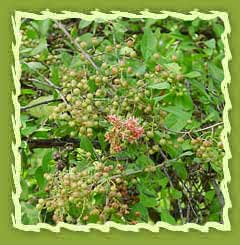It is originated in tropical America. It is cultivated in Andhra Pradesh,
Maharashtra, Karnataka, Bihar, Orissa, Assam, and Tamil Nadu besides India,
it is common in China, Philippines, Egypt and Central Africa.
Description of Custard apple :
A small tropical tree, indigenous to the Amazon rainforest, growing up to
20' tall. The leaves are thin, oblong while the flowers are greenish -
yellow. The conical fruit, with a purple knobby skin, is very sweet and is
eaten fresh or can be used for shakes. The fruit is juicy and creamy -
white. It is dull-green on the upperside, pale, with a bloom, below. It is
slightly hairy when young, aromatic when crushed. Along the branch tips,
opposite the leaves, the fragrant flowers are borne singly or in groups of 2
to 4. They are oblong, never fully open with 1 in (2.5 cm) long, drooping
stalks and 3 fleshy outer petals, yellow-green on the outside and
pale-yellow inside with a purple or dark-red spot at the base.

Appearance : Thick juicy liquid
Aroma : Sweet, woody aroma
Color : Pale green to lemony
Chemical constituents:: oil has various chemical compounds
that include ?- and ?-pinene, E-ocimene, germacrene-D, methyl and ethyl
butanoate and methyl hexanoate.
Extraction: cold expression of the seed.
Pharmaceutical uses:
In India the crushed leaves are sniffed to overcome hysteria and fainting
spells, they are also applied on ulcers and wounds and a leaf decoction is
taken in cases of dysentery. Throughout tropical America, a decoction of the
leaves alone or with those of other plants is imbibed either as an
emmenagogue, febrifuge, tonic, cold remedy, digestive or to clarify the
urine. The leaf decoction is also employed in baths to alleviate rheumatic
pain. The green fruit, very astringent is employed against diarrhea in El
Salvador. The crushed ripe fruit, mixed with salt, is applied on tumors. The
bark and roots are both highly astringent. The bark decoction is given as a
tonic and to halt diarrhea. The root, because of its strong purgative
action, is administered as a drastic treatment for dysentery and other
ailments.
Flavorings:
The fruits are generally used as fresh, while some products or
mixed fruits for the preparation of custard powders, ice creams and
puddings.
The ripe custard apple is usually broken open and the flesh segments are
enjoyed while the hard seeds are separated in the mouth and spat out. In
Malaya, the flesh is pressed through a sieve to eliminate the seeds and is
then added to ice cream or blended with milk to make a cool beverage. It is
never cooked. Most widespread throughout the tropics is the making of
refreshing soursop drinks (called champola in Brazil, carato in Puerto
Rico). For this purpose, the seeded pulp may be pressed in a colander or
sieve or squeezed in cheesecloth to extract the rich, creamy juice, which is
then beaten with milk or water and sweetened. The seeded pulp may be blended
with an equal amount of boiling water and then strained and sweetened.
Annonas are used mostly to make drinks or flavor frozen desserts.
Industrial uses:
The
seed kernels contain 14-49% of whitish or yellowish,
non-drying oil with saponification index of 186.40. It has been proposed as
a substitute for peanut oil in the manufacture of soap and can be detoxified
by an alkali treatment and used for edible purposes. The leaves yield an
excellent oil rich in terpenes and sesquiterpenes, mainly B-caryophyllene,
which finds limited use in perfumes, giving a woody spicy accent. The bark
of the tree has been used in tanning.
Fiber extracted from the bark has been employed for
cordage. The tree serves as host for lac-excreting insects.
When pulverized, the seeds are effective pesticides against head lice,
southern army worms and pea aphids.
Leaves: The leaf decoction is lethal to head lice and
bedbugs.
